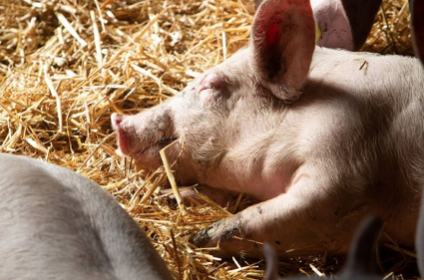Pig management expert John Gadd became intrigued by a recent farm visit featuring a pig farm in Germany, keeping pigs on straw. Here is his view on that development – and what it takes to make it into a success.
养猪业专家John Gadd最近参观了德国的一个养猪场,该猪场使用厚铺秸秆垫料发酵床养猪。以下是他对这一发展的看法,以及如何使其取得成功。
The ins (and outs) of deep straw
厚铺秸秆的投入(与产出)
Living and working in a predominantly cereal growing area, I grew up with deep straw both for dry sows and post-weaners and have long been a firm convert, so was glad to see the costings of one enterprising German farmer in Pig Progress (in December 2018) comparing both new conventional and new fully automated deep straw housing for 2,000 grow-finishing places. His careful costings revealed that the relatively new straw-bedded housed pigs cost € 58/pig place (12.7%) less than the equally new conventional housing.
生活和工作于一个以谷物种植为主的地方,我从小接触到用秸秆垫料发酵床养怀孕母猪及断奶仔猪,并且是一个忠实拥趸,因此我很高兴看到2018年12月Pig Progress有一期文章讲述德国一家养猪企业对使用传统方法以及发酵床养2000头育肥猪的成本做的对比。经过仔细计算,该猪场发现应用相对新的发酵床猪舍与同等传统猪舍相比,每头育肥猪的猪圈建造成本便宜了58欧元(12.7%)。

Weaner pig enjoying the straw in Heinz’ farm, Germany – the farm John Gadd refers to in his column. Photo: Ronald Hissink
德国海因茨猪场一头正在享受秸秆发酵床的断奶仔猪,这也是John Gadd专栏中提到的猪场。照片:Ronald Hissink
From his records the straw bedded pigs performed similarly to the conventionally housed pigs but no figures were provided for the cost of straw which these days can be expensive. Some 10 kg of straw was needed per 10 kg of feed – about 30 kg of straw per pig place (per batch?) through to slaughter, one presumes from leaving nursery accommodation.
从他的记录来看,发酵床养猪的表现与传统的猪圈养猪相似,但没有提供秸秆成本的数据,而目前秸秆的价格可能很昂贵。每10公斤饲料大约需要10公斤稻草——从离开保育舍到屠宰每头猪(每批?)大约需要30公斤稻草。
Drawbacks of deep straw
发酵床的缺点
What is of interest is that an additive is added to the straw to facilitate composting and reduce the physical labour needed to keep the straw bed ‘working’ which we found could be a disadvantage, and along with the cost of straw puts people off. So this innovation of pre-treating the straw into a marketable compost is important. Big Dutchman can advise on what the German producer uses.
有趣的是需要往秸秆中添加一种添加剂,来促进堆肥并减少让发酵床生效需要的体力劳动,我们发现这可能是一个缺点,而秸秆的成本也会让人望而却步。所以这种创新的预处理秸秆转变成市面可用的堆肥是很重要的。大荷兰人可以就德国生产商使用的材料提供建议。
On the other hand, most deep straw units in a cereal growing area, especially where the producer feeds his pigs from his own farm-grown grain and stores, then distributes used straw bedding on to his cereal acreage, makes the deep straw concept viable.
另一方面,在谷物种植区的大多数厚铺秸秆发酵床,特别是生产者使用自己种植的谷物喂自家的猪,再把使用过的秸秆用于谷物种植,使这个概念更可行。
But outside cereal-rich farmland I have always found that careful calculations on the cost of procuring ‘off-farm’ straw and the cost of removing it economically must be considered and factored in to the proposition. Farmers can be easily swayed by observing how calm and contented any pig is in a deep straw bed.
但在谷物丰富的种植区域之外,我总是发现,必须仔细计算从农场以外渠道获取秸秆的成本,以及移除秸秆的成本,并将其考虑在内。看到一头猪躺在厚厚的发酵床上时多么平静和满足,养猪户很容易动摇。
Housing cost can be much cheaper
猪舍成本可以便宜得多
It is worth remembering that many existing deep straw-bedded units already have buildings available or have hired them from neighbours such as disused cattle courts, which have run out very cheaply. From the records of 8 of my clients, a saving of around 45% from a conventional solid or slatted floored building and with slight modifications and despite an 8% increase in labour cost (to keep the bedding ‘sweet’) have made such conversions attractive.
值得一提的是,许多现有的发酵床单元已经有可用的建筑,或者是从邻居那里租来的,比如废弃的养牛场,它们已经非常便宜地用完了。从我的8个客户的记录来看,比传统的实心或板条地板建筑节省了45%左右,而且只做了少许改动,尽管劳动力成本增加了8%(为了让发酵床保持“温馨”),但这样的改造还是很有吸引力的。
Also many Electronic Sow Feeding (ESF) dry sow installations are on deep straw although a different layout design on hard standing is perfectly viable.
此外,许多电子母猪喂养(ESF)妊娠母猪栏应用在发酵床猪舍,虽然不同的布局设计在硬质围栏中是完全可行的。
Do deep strawed pigs perform better?
发酵床养猪生产性能是否更佳?
From the contentment angle it seems that they ought to. But I have been disappointed to find that there is a slight improvement in-the-nursery-onwards pigs which is usually increased by about double to slaughter, but records when available have thrown up little difference, which seems typical today. However, 2 clients report Meat produced per Tonne of Feed (MTF) improvement over slatted housing of 13 kg.
从满足的角度看,似乎应该达到这个效果。但令我失望的是,生猪性能只是略有改善,通常情况下到屠宰时可达两倍左右,但可用的记录几乎没有变化,这在今天似乎很典型。然而,2个客户报告每吨饲料的肉类产量(MTF)比漏缝地板的提高了13公斤。
Moving straw in and out
把秸秆搬进搬出
Looking back on my clients’ records (11 farms) since 2000, their operating costs, i.e. moving straw in and out as muck, and labour costs rose by 1% on the total cost of producing a finished pig.
回顾一下我的客户自2000年以来的记录(11家农场),他们的运营成本,即把秸秆作为粪肥运进运出的成本,以及劳动力成本,生产一头成品猪的总成本增加了1%。
Conclusions on deep straw in pigs:
Deep straw is viable, but needs careful operating calculations if not in a cereal-based locality;
If so, the German method of treating the straw beforehand looks to be a useful development as it removes nearly all the disadvantage of the physical labour needed to manage the deep straw;
Done well, the pigs seem very content. And their owners pleased. There is less aggression;
Disease varies. Converting to deep straw on a shoestring i.e. over-stocking, will increase the risk of disease. Deep straw needs ample space.
厚铺秸秆对猪的影响:
•厚铺秸秆是可行的,但如果不是在以谷物生产为主的地区,则需要仔细的运营计算;
•如果是这样的话,德国预先处理秸秆的方法看起来是一种有益的发展,因为它消除了需要人工处理秸秆的缺点;
•做得好的话,猪似乎很满足。它们的主人很高兴。攻击行为也随着减少;
•疾病各异。如果过度囤积秸秆,会增加患病的风险。厚铺秸秆需要足够的空间。
原文链接
https://www.pigprogress.net/Finishers/Articles/2019/4/Deep-straw-in-pigs--when-does-it-work-413557E/
来源:Pig Progress
(文/爱猪网记者刘坤颖编译,爱猪网原创,转载请注明出处)










